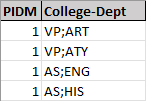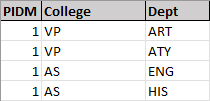Looks like I can’t reply to topics either now…
@d.chek hope you get this.
let
Source = Table.FromRows(Json.Document(Binary.Decompress(Binary.FromText("i45WMlTSUQoLABKOQSEgMhhIBARHKsXGAgA=", BinaryEncoding.Base64), Compression.Deflate)), let _t = ((type nullable text) meta [Serialized.Text = true]) in type table [PIDM = _t, #"College 1" = _t, #"Dept 1" = _t, #"College 2" = _t, #"Dept 2" = _t]),
#"Changed Type" = Table.TransformColumnTypes(Source,{{"PIDM", Int64.Type}, {"College 1", type text}, {"Dept 1", type text}, {"College 2", type text}, {"Dept 2", type text}}),
#"Merged Columns" = Table.CombineColumns(#"Changed Type",{"College 1", "Dept 1"},Combiner.CombineTextByDelimiter(";", QuoteStyle.None),"College-Dept-1"),
#"Merged Columns1" = Table.CombineColumns(#"Merged Columns",{"College 2", "Dept 2"},Combiner.CombineTextByDelimiter(";", QuoteStyle.None),"College-Dept-2"),
#"Unpivoted Columns" = Table.UnpivotOtherColumns(#"Merged Columns1", {"PIDM"}, "Attribute", "Value"),
#"Removed Columns" = Table.RemoveColumns(#"Unpivoted Columns",{"Attribute"}),
#"Split Column by Delimiter" = Table.SplitColumn(#"Removed Columns", "Value", Splitter.SplitTextByDelimiter(";", QuoteStyle.Csv), {"Value.1", "Value.2"}),
#"Changed Type1" = Table.TransformColumnTypes(#"Split Column by Delimiter",{{"Value.1", type text}, {"Value.2", type text}}),
#"Renamed Columns" = Table.RenameColumns(#"Changed Type1",{{"Value.1", "College"}, {"Value.2", "Dept"}})
in
#"Renamed Columns"
d chek eDNA.pbix (18.7 KB)

